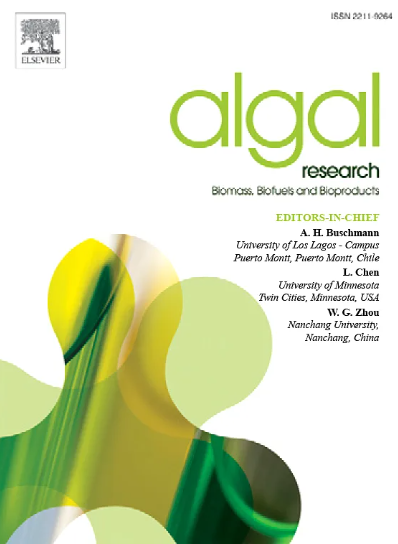AP-cyan - 用于藻类培养的潜在抗坏血酸探针
IF 4.6
2区 生物学
Q1 BIOTECHNOLOGY & APPLIED MICROBIOLOGY
Algal Research-Biomass Biofuels and Bioproducts
Pub Date : 2024-10-10
DOI:10.1016/j.algal.2024.103743
引用次数: 0
摘要
抗坏血酸(Asc)是一种重要的抗氧化剂,也参与植物的各种生物过程,如激素代谢、应激反应和信号途径。Asc 也是人类健康的重要维生素,通过生物强化来提高其含量是一个理想的目标。因此,评估 Asc 含量的可靠原位方法至关重要。然而,大多数现有的 Asc 检测荧光探针仅限于液体样品,如人类血清或植物提取物,或者需要复杂的技术和设备进行细胞内检测,如光诱导电子转移或时间门控发光显微镜。此外,许多这类探针都不具有细胞壁渗透性,因此不能用于植物或藻类细胞。在这篇文章中,我们介绍了一种基于反应的 Asc 探针--AP-cyan,它可以在各种微藻培养物中高效、定性地检测 Asc,其中包括绿衣藻、小球藻(Chlorella sorokianiana)和副球藻(Parachlorella kessleri)。该探针使用简单,能快速得出结果,可使用标准荧光显微镜和基本的蓝色、绿色和红色滤光片进行观察。该探针的发射范围(λem = 488 nm)与叶绿素自发荧光不重叠,因此适用于藻类细胞。因此,我们的探针为检测微藻类细胞中的 Asc 提供了一种简单而强大的方法。本文章由计算机程序翻译,如有差异,请以英文原文为准。
AP-cyan – A potential ascorbate probe for algal cultures
Ascorbate (Asc) is an important antioxidant that also participates in various biological processes in plants such as hormone metabolism, stress response and signaling pathways. Asc is also a vital vitamin for human health and enriching its content through biofortification is a desirable objective. Therefore, reliable in situ methods for assessing Asc levels are essential. However, most of the existing fluorescent probes for Asc detection are limited to liquid samples, such as human sera or plant extract, or require sophisticated techniques and equipment for in-cell detection, such as photo-induced electron transfer or time-gated luminescence microscopy. Moreover, many of these probes are not cell wall permeable and cannot be used in plants or algal cells. In this article, we introduce a reaction-based, Asc probe – AP-cyan, that can efficiently and qualitatively detect Asc in various microalgal cultures, including Chlamydomonas reinhardtii, Chlorella sorokianiana and Parachlorella kessleri. The probe is simple to use and produces fast results that can be observed with standard fluorescence microscopes with basic blue, green and red filters. The probe has an emission range (λem = 488 nm) that does not overlap with chlorophyll autofluorescence, making it suitable for algal cells. Thus, our probe offers a simple and powerful method to detect Asc in microalgal cells.
求助全文
通过发布文献求助,成功后即可免费获取论文全文。
去求助
来源期刊

Algal Research-Biomass Biofuels and Bioproducts
BIOTECHNOLOGY & APPLIED MICROBIOLOGY-
CiteScore
9.40
自引率
7.80%
发文量
332
期刊介绍:
Algal Research is an international phycology journal covering all areas of emerging technologies in algae biology, biomass production, cultivation, harvesting, extraction, bioproducts, biorefinery, engineering, and econometrics. Algae is defined to include cyanobacteria, microalgae, and protists and symbionts of interest in biotechnology. The journal publishes original research and reviews for the following scope: algal biology, including but not exclusive to: phylogeny, biodiversity, molecular traits, metabolic regulation, and genetic engineering, algal cultivation, e.g. phototrophic systems, heterotrophic systems, and mixotrophic systems, algal harvesting and extraction systems, biotechnology to convert algal biomass and components into biofuels and bioproducts, e.g., nutraceuticals, pharmaceuticals, animal feed, plastics, etc. algal products and their economic assessment
 求助内容:
求助内容: 应助结果提醒方式:
应助结果提醒方式:


